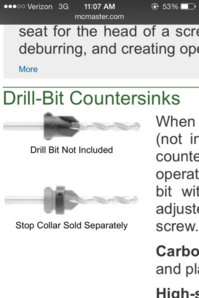MarsFab
Will work for money
- Joined
- Oct 24, 2007
- Location
- Harrisburg, NC
What do you fab guys use to chamfer holes in metal? I've tried countersinks 6 flute, single flute, no flute. I've tried uni-bits. I've tried small hand de-burring tools. I've even tried custom grinding my own larger bit. No matter what tool I use I can't get a clean finished hole especially in aluminum. I always end up with a flared ring around the hole where the cutting tool rolls up an edge.
This becomes a pretty irritating problem when you build something out of nice clean un-scratched aluminum and the holes need to be sanded to get the rough edge off of them. I can't sand it. That's the whole point in using clean metal.
This becomes a pretty irritating problem when you build something out of nice clean un-scratched aluminum and the holes need to be sanded to get the rough edge off of them. I can't sand it. That's the whole point in using clean metal.


 I may still have it. I didn't have any flaring with the metal but some with the aluminum. Thinking about it, I'm also wondering how you would get a clean cut on aluminum like you want. That was useless, I know
I may still have it. I didn't have any flaring with the metal but some with the aluminum. Thinking about it, I'm also wondering how you would get a clean cut on aluminum like you want. That was useless, I know


 I always need a reason to build another tool! :evilgrin: I may just do that. It'll probably need a 40" throat though. I may see a new combo bead roller deep throat punch build in my near future. Hmmm....
I always need a reason to build another tool! :evilgrin: I may just do that. It'll probably need a 40" throat though. I may see a new combo bead roller deep throat punch build in my near future. Hmmm....